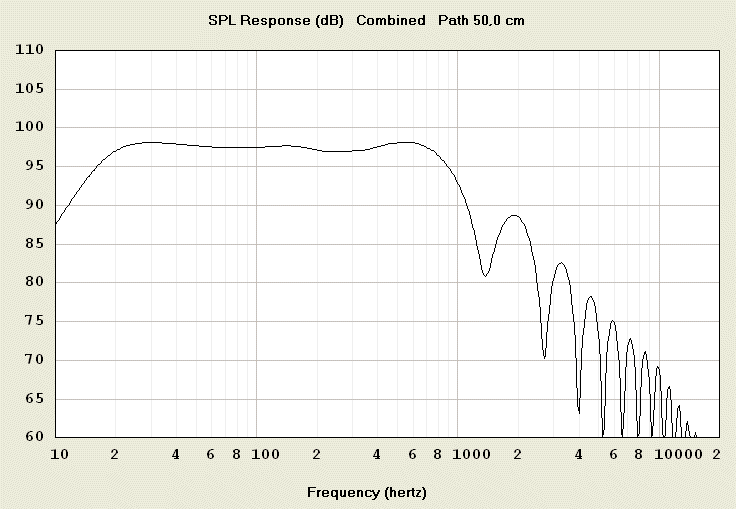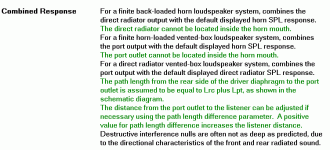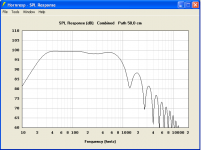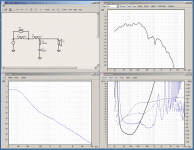I have simulated several pro drivers and this one from STX seems good for this task? I could get better only with a large closed box. Isn't better show combined path at 2m at listening position?
This is 16Ohm woofer so Eg=4V.
This is 16Ohm woofer so Eg=4V.
Last edited:
Hey Jean-Michel,
I guess corner loading is mandantory for this concept as you also recommended that in my 414 project a few posts back? Think this also incorporated an added R that made sensitivity low?
Hey Jack,
Find a driver with lower Mms. This will give you a bandwith so you can go for a 1" inch driver and a smaller horn, like your JMLC-400. What was wrong with the low cost 12" you suggested me? It will not need the high compression the 15" gives together withe the JMLC-200.
I guess corner loading is mandantory for this concept as you also recommended that in my 414 project a few posts back? Think this also incorporated an added R that made sensitivity low?
Hey Jack,
Find a driver with lower Mms. This will give you a bandwith so you can go for a 1" inch driver and a smaller horn, like your JMLC-400. What was wrong with the low cost 12" you suggested me? It will not need the high compression the 15" gives together withe the JMLC-200.
Last edited:
Hello Jack,
The difference of path we indicate in the "combined response" module of Hornresp is not related to the listening distance.
It is the difference of path travelled by the rear wave compared to the front wave. In the case of the Horn Open Baffle the difference of path is roughly a bit larger than the distance between the troat of the horn and the edge of its mouth + some additional.
See attached Hornresp help file related to the combines response.
Best regards from Paris, France
Jean-Michel Le Cléac'h
The difference of path we indicate in the "combined response" module of Hornresp is not related to the listening distance.
It is the difference of path travelled by the rear wave compared to the front wave. In the case of the Horn Open Baffle the difference of path is roughly a bit larger than the distance between the troat of the horn and the edge of its mouth + some additional.
See attached Hornresp help file related to the combines response.
Best regards from Paris, France
Jean-Michel Le Cléac'h
I have simulated several pro drivers and this one from STX seems good for this task? I could get better only with a large closed box. Isn't better show combined path at 2m at listening position?
This is 16Ohm woofer so Eg=4V.
Attachments
Question remains why we use a half of available JMLC200 mouth area and can we improve performance a little bit with lower cut-off.
Variable path length due to varying group delay of horn.
Probably off topic here but I would like to ask jmmlc whether the above is taken into account in horn response calculations. I ask because I have been modelling some front loaded horns working off an offset H baffle type open baffle and the results look good. I have used eminence beta 15A in the models as that is what I have and find difficulty in using them.
With two in an H baffle,8"or 20cm deep to the rear and a port opening equal to the H baffle cross section but .01cm deep and the front part of the H baffle about 8cm. deep but closed off to make a chamber with a throat area to the horn of 480 - 500sq.cm, mouth area 5000 - 600 sq.cm depending on profile, results look quite good. The lack of xmax shows up low down. I have modelled path difference as the length of the baffle plus the length of the horn. Is this correct.
This seems, generally to give better results than a bass reflex/horn combination. I suspect that better speakers would model quite well in this type of setup.
jamikl
Probably off topic here but I would like to ask jmmlc whether the above is taken into account in horn response calculations. I ask because I have been modelling some front loaded horns working off an offset H baffle type open baffle and the results look good. I have used eminence beta 15A in the models as that is what I have and find difficulty in using them.
With two in an H baffle,8"or 20cm deep to the rear and a port opening equal to the H baffle cross section but .01cm deep and the front part of the H baffle about 8cm. deep but closed off to make a chamber with a throat area to the horn of 480 - 500sq.cm, mouth area 5000 - 600 sq.cm depending on profile, results look quite good. The lack of xmax shows up low down. I have modelled path difference as the length of the baffle plus the length of the horn. Is this correct.
This seems, generally to give better results than a bass reflex/horn combination. I suspect that better speakers would model quite well in this type of setup.
jamikl
They don't work in reality 🙁
How do you know? You said you only ran OB. It also sims good as vented horn. Still you have to try IRL!
It also sims good with a vented backchamber with a 150Hz Tractrix down to 70Hz.
Last edited:
See measurements. There's extension that can shake your body but bass is quiet. I have one 90 deg JMLC-200T (65cm) for experiments.
Totally impossible to use a horn with 20cm2(if you use the 200T as is). And the other 200 with T=0 shouldn´t be the best either. At for the horn must be 350-400cm2.
In my opinion your 15" is probably not the best for horn use.
In my opinion your 15" is probably not the best for horn use.
Last edited:
Do you😉? This is the 414 with 10ohm in series....

Low sensitivity though.
Better to use a coil
Better to use a coil
Hey Helmuth,
You probably missunderstood the use of the resistor. It is for making the driver get higher Q. Unfortunately you loose sensitivity so it isn´t the best of ideas.
Jack have suggested a driver giving us high sensitivity, Eminence Kappa 15A, that sims fine as OB without more than 2ohm. This is Zout of a typical 300B/2A3 SE. Will sim some more.
For what reason? Absolutely none in my eyes! If the driver needs compensation you shouldn´t use it. Find another!
The reason is better impulse behavior and higher damping at resonance.For what reason? Absolutely none in my eyes! If the driver needs compensation you shouldn´t use it. Find another!
- Home
- Loudspeakers
- Multi-Way
- Jean Michel on LeCleac'h horns


